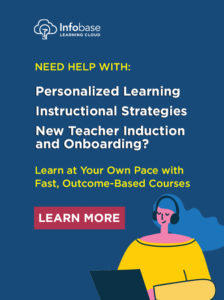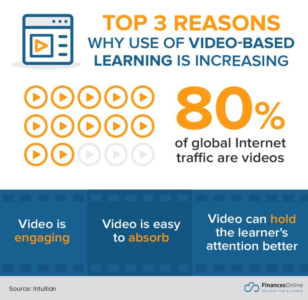If you’re considering investing in online learning tech, knowing where to start may feel overwhelming. Technology has revolutionized today’s learning experience. Teaching no longer has to be confined to a classroom environment, and with the online learning sector forecast to exceed USD 375 billion by 2026, this is a trend that isn’t going anywhere soon.
Due to the COVID-19 pandemic, online learning has moved from innovative to the “new normal,” and the world of technology is helping educational institutions and business organizations to rise to the challenges of managing virtual teams.
Keeping in touch has never been easier. For example, tech such as CTI telephony (computer telephony integration) enables modern employees to use their computer system to interact with their company phone system from anywhere.
We frequently hear the saying, “Start with why.” And this is what we’d recommend if you’re considering investing in new tech. Think about why you want students to learn and how you would like them to experience the process.
In our experience, the most important questions you will need to ask can be broken down into the three broad categories listed below. There are now lots of online learning tech or “ed-tech” products on the market, providing an excellent choice.
Read on to discover what you need to consider to find the perfect solution for your organization.
1. Is the Tech Easily Accessible to All Stakeholders and Students?
Whether you are considering implementing new online learning technology as part of a blended learning curriculum or as a full alternative to face-to-face tuition, accessibility is everything. That is why it’s vital to choose the right tools to support learning.
There is no one-size-fits-all solution for online learning; all education providers are individuals and must choose the technology that fits their specific needs. Consider what makes your organization unique and evaluate the technical skills of your team. This may be an opportunity to identify extra training needs.
Students and their tutors need access to a good Internet connection and capable hardware, but this is just the beginning. How easy will it be for everybody to access your new tools? For example, if you need to provide learning content for people with different first languages, you’ll need to source software with translation features.
Every student needs to be able to collaborate and express themselves. Have you considered how students with a hearing or vision impairment will be able to access your content over a new learning platform? Think about how technology can help you to be fully inclusive. For example, is any software compatible with adapted keyboards for touch panel technology?
How Easy Is the Online Learning Technology to Use?
It’s important to remember that students and educators will all have different skill levels when it comes to using technology. You will need to ensure that everyone is going to be able to use this system and factor in extra training for those who can’t. Tech should increase access to learning in the following ways:
- By giving multiple points of access to a particular lecture or session
- By providing easy access when updates are made
- By ensuring easy scalability if student numbers suddenly increase
- By not requiring students or teachers to access a particular physical location
What Support Is Available from the Technology Provider?
When considering different providers, pay attention to the level of support that is on offer to help students and tutors to access their software. For example, RingCentral provides lots of supportive content, such as “How to share your screen in 3 easy steps with RingCentral Video.”
Any extra support provided over and above competitors should be regarded as a real plus point.
2. Will My Organization Save Time and Money?
Technology has been shown to improve organizations’ efficiency and profitability. For example, an IVR system can save a call center both time and money by interacting with callers via recorded messages rather than human operatives.
There are three ways to use cloud computing for your business or educational organization: IaaS, PaaS, and SaaS. We’re going to focus on the latter. When you invest in online learning tech, it’s possible to use software that is available over the internet via a third party. This is known as SaaS. SaaS examples include providers such as RingCentral.
SaaS can provide the following benefits:
- Lower cost of entry
- Pay-as-you-go model that reduces risk
- Easy scaling up
- The flexibility to work from wherever there is an Internet connection
- Regular updates that provide cutting-edge innovation
- Reduced risk and spend on IT infrastructure, meaning the money and time saved can be directed elsewhere
Only Pay for the Tech You Need
 Take care to make sure that any package you agree to will cover only the technology that you’ll actually be using. It’s easy to end up paying extra for software that isn’t necessary or suitable for your organization’s requirements.
Take care to make sure that any package you agree to will cover only the technology that you’ll actually be using. It’s easy to end up paying extra for software that isn’t necessary or suitable for your organization’s requirements.
“Shelfware” is the name for software that has been paid for but isn’t used. An example of this is when a company buys more software licenses than it ends up using.
It’s important to note here that in the initial stages of your decision, testing different options can be a good strategy. This may be less costly than you think. Signing up for trial versions can often allow you to try different options for free before you buy.
Is the Online Learning Technology Safe and Secure?
Choosing online learning technology that isn’t secure could be a very costly mistake. It’s important to pay attention to security and privacy considerations. Digital learning tools should be vetted and sourced from providers who are compliant with regulatory obligations.
Cloud-based infrastructures need robust cloud access security broker (CASB) solutions to ensure integrity and security. Top CASB vendors provide security software positioned between users and cloud services, playing the critical role of enforcing security policies for accessing cloud services.
It’s important to also consider content security. If you protect your content from unauthorized copying, for example, by converting it to virtual flipbooks, you will be able to share it without worrying. Plagiarism is an increasing problem in today’s online world. It’s vital to do everything in your power to protect your valuable intellectual property.
3. Will Learning Outcomes Be Improved as a Direct Result?
It’s important to remember that the key objective here is to deliver meaningful learning experiences when training remote employees or students. Technology must enhance the learning process rather than just being impressive in its own right. It doesn’t matter how advanced the technology in your new course material is if it doesn’t improve learning outcomes.
There is no substitute for the knowledge and experience of a real human tutor, and the learning tools should increase his or her capabilities. The effective integration of technology
can help you to manage the processes used by your most vital asset—your team. Workforce management software is an example of this.
The most effective learning software will simplify admin tasks, communication, tracking, and monitoring. However, it won’t detract from your tutor’s ability to teach their students.
Identifying Individual Strengths and Weaknesses
Using the right online learning technology can help to deepen learning and make the process more efficient. It allows the collection of data that will help you to identify each student’s strengths and weaknesses. This allows you to offer a more tailored approach, making learning more enjoyable and, ultimately, more effective.
Have Other Organizations Had Success with This Technology?
Pay attention to reviews, user satisfaction statistics, and even word-of-mouth referrals from similar organizations. They offer valuable guidance and attest to the provider’s reliability. These feedback mechanisms will show whether a particular online learning tool is a good fit for your curriculum and standards.
Do Your Homework to Enable Optimum Learning Experiences
When it comes to improving teacher-student communication in virtual classrooms, it pays to listen to your team of educators. Paying attention to the very people who will be on the front line of using the new tech you invest in is vital, as is reviewing your organization’s goals. Setting both short- and long-term goals will help you to focus.
Conducting a thorough analysis of what is currently working well within your organization (and what isn’t) can be helpful. This can identify the requirements for any new online tools. However, while it is important to monitor remote employees, don’t forget to respect privacy and observe data protection rules.
Choosing the right tools to invest in will allow your organization to concentrate on providing the optimum learning experience. This process should help to save both time and money.
With the great variety of online learning tech that is now available, there is more choice than ever before. That is why it’s important to take your time and consider carefully, taking into account all the factors we’ve outlined above.
See also:
- Learn more about Infobase Learning Cloud: Professional Development and Training
- 8 Reasons Students Need Technology in the Classroom
- What Is Edge Computing, and Why Would It Benefit the K–12 Classroom?
- How Libraries Can Benefit from Integrating Artificial Intelligence
- Teaching Instructors How to Create Accessible Courses






